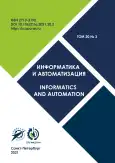Том 20, № 3 (2021)
Искусственный интеллект, инженерия данных и знаний
Аналитический обзор систем автоматического определения депрессии по речи
Аннотация
 497-529
497-529


Модель информационного взаимодействия элементов многоуровневой системы цифровых двойников
Аннотация
 530-561
530-561


Формализация регулятивных текстов
Аннотация
 562-590
562-590


Реализация поведенческих функций на спайковых нейронных сетях
Аннотация
 591-622
591-622


Эффективный алгоритм классификации естественного языка обнаружения повторяющихся контролируемых признаков
Аннотация
Эта статья фокусируется на том, чтобы уловить смысл значения текстовых функций понимания естественного языка (NLU) для обнаружения дубликатов неконтролируемых признаков. Особенности NLU сравниваются с лексическими подходами для доказательства подходящей методики классификации. Подход трансфертного обучения используется для обучения извлечению признаков в задаче семантического текстового сходства (STS). Все функции оцениваются с помощью двух типов наборов данных, которые принадлежат отчетам об ошибках Bosch и статьям Википедии. Цель данного исследованияструктурировать последние исследовательские усилия путем сравнения концепций NLU для описания семантики текста и применения их к IR. Основным вкладом данной работы является сравнительное исследование измерений семантического сходства. Экспериментальные результаты демонстрируют результаты функции Term Frequency–Inverse Document Frequency (TF-IDF) для обоих наборов данных с разумным объемом словаря. Это указывает на то, что двунаправленная долговременная кратковременная память (BiLSTM) может изучать структуру предложения для улучшения классификации.
 623-653
623-653


Математическое моделирование и прикладная математика
Построение комплексных расписаний выполнения пакетов заданий при формировании комплектов в заданные директивные сроки
Аннотация
 654-689
654-689


Метод оптимизации траектории мобильного робота в поле источников-репеллеров
Аннотация
 690-726
690-726


Вероятностный анализ обобщённой статистической модели многолучевого канала SIMO системы с замираниями и коррелированными затенениями
Аннотация
 727-749
727-749












